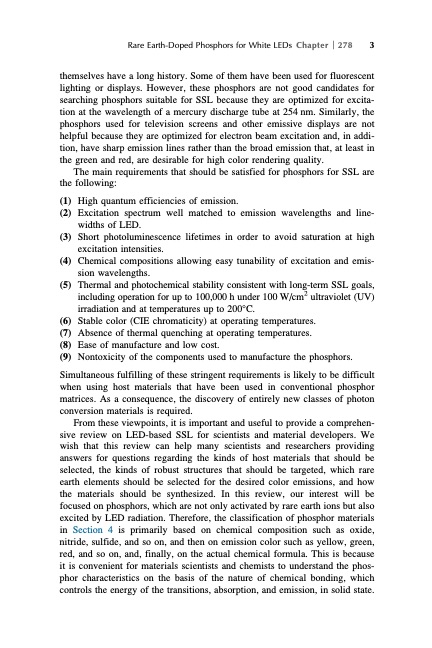
PDF Publication Title:
Text from PDF Page: 039
Rare Earth-Doped Phosphors for White LEDs Chapter 278 3 themselves have a long history. Some of them have been used for fluorescent lighting or displays. However, these phosphors are not good candidates for searching phosphors suitable for SSL because they are optimized for excita- tion at the wavelength of a mercury discharge tube at 254 nm. Similarly, the phosphors used for television screens and other emissive displays are not helpful because they are optimized for electron beam excitation and, in addi- tion, have sharp emission lines rather than the broad emission that, at least in the green and red, are desirable for high color rendering quality. The main requirements that should be satisfied for phosphors for SSL are the following: (1) High quantum efficiencies of emission. (2) Excitation spectrum well matched to emission wavelengths and line- widths of LED. (3) Short photoluminescence lifetimes in order to avoid saturation at high excitation intensities. (4) Chemical compositions allowing easy tunability of excitation and emis- sion wavelengths. (5) Thermal and photochemical stability consistent with long-term SSL goals, including operation for up to 100,000 h under 100 W/cm2 ultraviolet (UV) irradiation and at temperatures up to 200°C. (6) Stable color (CIE chromaticity) at operating temperatures. (7) Absence of thermal quenching at operating temperatures. (8) Ease of manufacture and low cost. (9) Nontoxicity of the components used to manufacture the phosphors. Simultaneous fulfilling of these stringent requirements is likely to be difficult when using host materials that have been used in conventional phosphor matrices. As a consequence, the discovery of entirely new classes of photon conversion materials is required. From these viewpoints, it is important and useful to provide a comprehen- sive review on LED-based SSL for scientists and material developers. We wish that this review can help many scientists and researchers providing answers for questions regarding the kinds of host materials that should be selected, the kinds of robust structures that should be targeted, which rare earth elements should be selected for the desired color emissions, and how the materials should be synthesized. In this review, our interest will be focused on phosphors, which are not only activated by rare earth ions but also excited by LED radiation. Therefore, the classification of phosphor materials in Section 4 is primarily based on chemical composition such as oxide, nitride, sulfide, and so on, and then on emission color such as yellow, green, red, and so on, and, finally, on the actual chemical formula. This is because it is convenient for materials scientists and chemists to understand the phos- phor characteristics on the basis of the nature of chemical bonding, which controls the energy of the transitions, absorption, and emission, in solid state.PDF Image | HANDBOOK ON THE PHYSICS AND CHEMISTRY OF RARE EARTHS

PDF Search Title:
HANDBOOK ON THE PHYSICS AND CHEMISTRY OF RARE EARTHSOriginal File Name Searched:
Chemistry-Rare-Earths-49.pdfDIY PDF Search: Google It | Yahoo | Bing
Sulfur Deposition on Carbon Nanofibers using Supercritical CO2 Sulfur Deposition on Carbon Nanofibers using Supercritical CO2. Gamma sulfur also known as mother of pearl sulfur and nacreous sulfur... More Info
CO2 Organic Rankine Cycle Experimenter Platform The supercritical CO2 phase change system is both a heat pump and organic rankine cycle which can be used for those purposes and as a supercritical extractor for advanced subcritical and supercritical extraction technology. Uses include producing nanoparticles, precious metal CO2 extraction, lithium battery recycling, and other applications... More Info
| CONTACT TEL: 608-238-6001 Email: greg@infinityturbine.com | RSS | AMP |